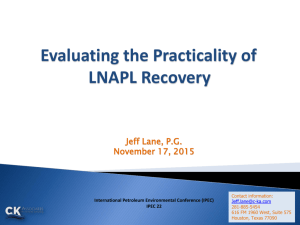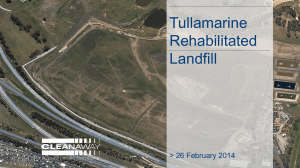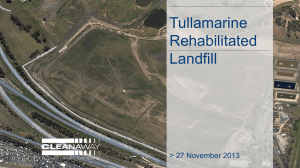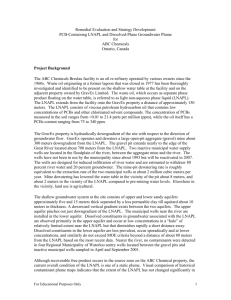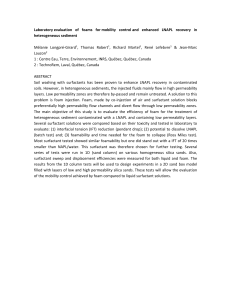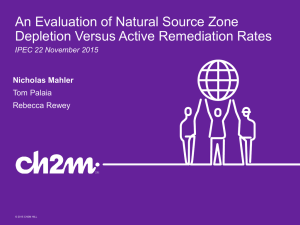LNAPL Saturation - CLU-IN
advertisement
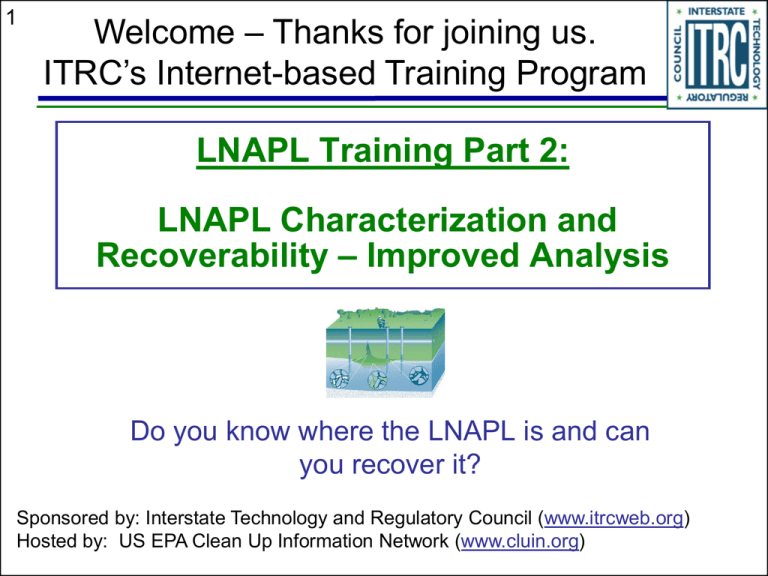
1 Welcome – Thanks for joining us. ITRC’s Internet-based Training Program LNAPL Training Part 2: LNAPL Characterization and Recoverability – Improved Analysis Do you know where the LNAPL is and can you recover it? Sponsored by: Interstate Technology and Regulatory Council (www.itrcweb.org) Hosted by: US EPA Clean Up Information Network (www.cluin.org) 2 Housekeeping Course time is 2¼ hours Question & Answer breaks • Phone - unmute *6 to ask question out loud Simulcast - ? icon at top to type in a question Turn off any pop-up blockers • Download slides as PPT or PDF Go to slide 1 Move back 1 slide Move forward 1 slide Move through slides • Arrow icons at top of screen • List of slides on left Feedback form available from last slide – please complete before leaving This event is being recorded Go to last slide Go to seminar homepage Submit comment or question Report technical problems Copyright 2013 Interstate Technology & Regulatory Council, 50 F Street, NW, Suite 350, Washington, DC 20001 3 ITRC Disclaimer This material was sponsored by an agency of the United States Government. The views and opinions of authors expressed herein do not necessarily state or reflect those of the United States Government or any agency thereof and no official endorsement should be inferred. The information in ITRC Products was formulated to be reliable and accurate. However, the information is provided "as is" and use of this information is at the users’ own risk. Information in ITRC Products is for general reference only; it should not be construed as definitive guidance for any specific site and is not a substitute for consultation with qualified professional advisors. ITRC Product content may be revised or withdrawn at any time without prior notice. ITRC, ERIS, and ECOS make no representations or warranties with respect to information in its Products. ITRC, ERIS, and ECOS will not accept liability for damages of any kind that result from acting upon or using this information. ITRC, ERIS, and ECOS do not endorse or recommend the use of specific technology or technology provider through ITRC Products. 4 ITRC (www.itrcweb.org) – Shaping the Future of Regulatory Acceptance Host organization Network • State regulators • • • • All 50 states, PR, DC • Federal partners DOE DOD EPA • ITRC Industry Affiliates Program Wide variety of topics Technologies Approaches Contaminants Sites Products • Technical and regulatory guidance documents • Internet-based and classroom training • Academia • Community stakeholders 5 ITRC Course Topics Planned for 2013 – More information at www.itrcweb.org Popular courses from 2012 New in 2013 Environmental Molecular Decision Framework for Applying Attenuation Processes to Metals and Radionuclides Diagnostics Development of Performance Specifications Biochemical Reactors for for Solidification/Stabilization Mining-Influenced Water Green and Sustainable Remediation Groundwater Statistics and Integrated DNAPL Site Strategy Monitoring Compliance LNAPL 1: An Improved Understanding of LNAPL Behavior in the Subsurface 2-Day Classroom Training on LNAPL 2: LNAPL Characterization and Recoverability - Improved Analysis Light Nonaqueous-Phase LNAPL 3: Evaluating LNAPL Remedial Liquids (LNAPLs) Technologies for Achieving Project Goals April 9-10 in King of Mine Waste Treatment Technology Selection Prussia, PA Project Risk Management for Site Remediation June 4-5 in Springfield, IL Use and Measurement of Mass Flux and Mass (tentative) October in Discharge Southern CA Use of Risk Assessment in Management of Contaminated Sites Soil Sampling and Decision Making Using Incremental Sampling Methodology (2 parts) Bioavailability Considerations for Contaminated Sediment Sites Biofuels: Release Prevention, Environmental Behavior, and Remediation 6 Meet the ITRC Trainers Pamela S. Trowbridge, P.G. Pennsylvania Department of Environmental Protection Harrisburg, PA 717-705-4839 ptrowbridg@pa.gov Derek W. Tomlinson, PE, PEng, LSRP Geosyntec Consultants, Inc. Blue Bell, PA 267-464-2800 dtomlinson@geosyntec.com Steven Ueland, P.E. Langan Engineering & Environmental Services Doylestown, PA 215-491-6500 sueland@langan.com 7 LNAPL Training Part 2 Introduction and Part 1 summary LNAPL conceptual site model LNAPL site characterization Q&A Hydraulic recovery evaluation and limits LNAPL management objectives and goals Introduction to LNAPL remedial technologies Q&A 8 LNAPL Training Part 2 Introduction and Part 1 summary LNAPL conceptual site model LNAPL site characterization Q&A Hydraulic recovery evaluation and limits LNAPL management objectives and goals Introduction to LNAPL remedial technologies Q&A 9 Part 1 Summary of LNAPL Basics LNAPLs do not form a “pancake,” but are distributed in multi-phase vertical equilibrium. LNAPL saturations are not uniform, controlled by soil heterogeneity. Specific volume of LNAPL in soil: For a given LNAPL thickness in a monitor well, more in coarse-grained and less in fine-grained soils. As LNAPL saturation increases, relative permeability, and LNAPL migration potential increases. 10 Part 1 Summary of LNAPL Basics (continued) Pressure exerted by LNAPL must exceed the displacement soil pore entry pressure for LNAPL to enter a water-filled soil pore. A measurable LNAPL thickness in a monitor well does not necessarily indicate that LNAPL is migrating. For water wet media Part 1 - Basic principles of LNAPL distribution and mobility Flow Part 2 - LNAPL characterization, Conceptual Site Model, and recovery evaluation Flow 11 Purpose of Today’s Training Event Better Understanding, Better Decisions Identify relevant LNAPL and site characterization data (what, how, why). Demonstrate use of Part 1 concepts in evaluating LNAPL recoverability. Discuss factors used to match remedial objectives with LNAPL remedial technologies. 12 Simplified Subsurface LNAPL Processes Release Source Vapor Phase LNAPL Dissolved Phase Modified from Huntley and Beckett, 2002 13 The Three Basic LNAPL Site Scenarios Covered in this training LNAPL sat > residual 1 LNAPL sat > residual 2 LNAPL sat < residual 3 Condition: LNAPL in wells, mobile Driver: LNAPL saturation Condition: LNAPL in wells, mobile, not migrating Driver: LNAPL composition, saturation Condition: No LNAPL in wells Driver: LNAPL composition 14 LNAPL Concerns and Drivers LNAPL Concerns: Explosive hazards Dissolved-phase concentration Vapor-phase concentration Direct contact or ingestion LNAPL driver: LNAPL Composition Mobility (spreads and creates new or increased risk) Visible aesthetics LNAPL Saturation Regulatory driver: “recover to maximum extent practicable” – State’s interpretation? 15 LNAPL Understanding is an Iterative Process LNAPL Characterization LNAPL composition LNAPL saturation LNAPL location LNAPL Conceptual Site Model LNAPL Management Maximum extent practicable? Drivers: mobility and future risk Remedial objectives and end points Remedial action selection 16 LNAPL Training Part 2 Introduction and Part 1 summary LNAPL conceptual site model LNAPL site characterization Q&A Hydraulic recovery evaluation and limits LNAPL management objectives and goals Introduction to LNAPL remedial technologies Q&A 17 LNAPL Conceptual Site Model (LCSM) Site characterization and management link Description and interpretation of physical and chemical state of the LNAPL body Facilitates understanding of the LNAPL conditions, site risks, and how best to remediate Scaled to the LNAPL impacts and associated issues that require management Iterative process to increase the understanding of the LNAPL body and site risks Sufficient when additional information likely would not lead to a different decision 18 LNAPL Conceptual Site Model (LCSM) LCSM used to understand • • • • • • • Delineation (horizontal and vertical) Age and Chemical/Physical Character Volume Mobility (or Stability) Longevity Recoverability Source / Pathway / Receptors LCSM used to help make management decisions 19 LCSM (Major) Components Utility corridor/ drain Source: Garg Drinking water well LNAPL emergency issues when LNAPL in the ground LNAPL Risk when LNAPL in the ground (evaluated using RCBA) accumulation in confined Groundwater 2 1 Vapor spaces causing explosive conditions (dissolved phase) 3a Not shown - Direct LNAPL migration 2 LNAPL to vapor to surface water 3b 2 Groundwater to vapor Not shown - Direct LNAPL migration Not shown - Direct skin to underground spaces contact Additional LNAPL Risks when LNAPL in wells (not evaluated using RCBA) LNAPL mobility (offsite 41 migration, e.g. to surface water, under houses) in well (aesthetic, 51 LNAPL reputation, regulatory) 20 Factors Affecting LCSM Complexity Potential Risk Factors Toxicity/Pathway Magnitude/GW use Mobility & mass in place/longevity Tier 3 Sites Hydrologic Variability Toxicity/Chemical mobility Geologic/transport complexity Business & Community Issues Low-degradability/ persistent compounds Hydrogeologic & Plume Factors Offsite Plume/Sensitive Receptors Tier 2 Sites Tier 1 Sites ASTM E2531, 2006 Example factors affecting LCSM Complexity. Note, .this is an example only, the boundary between Tiers is subjective based on user judgment 21 LNAPL Training Part 2 Introduction and Part 1 summary LNAPL conceptual site model LNAPL site characterization Q&A Hydraulic recovery evaluation and limits LNAPL management objectives and goals Introduction to LNAPL remedial technologies Q&A 22 LNAPL Site Characterization Building the LCSM Existing data Direct methods/conventional assessment Indirect methods Laboratory methods Database/empirical values Remember: Not all of these data may be necessary 23 Example LNAPL Indicators 1. Known LNAPL release 2. Observed LNAPL (for example, in wells or other discharges) 3. Visible LNAPL or other direct indicator in samples 4. Fluorescence response in LNAPL range 5. Near effective solubility or volatility limits in dissolved or vapor phases 6. Dissolved plume persistence and center-of mass stability 7. TPH concentrations in soil or groundwater indicative of LNAPL presence 8. Organic vapor analyzer (OVA) and other field observations 9. Field screening tests positive (for example, paint filter test, dye test, shake test) Modified from: ASTM E2531 Table 1 24 Considerations for Assessing LNAPL Presence Based on Observation Cr r ve i R k ee Cr Estimates of the source area can be based on observations in wells, boring logs, and other visual observations • Uncorrected observations should not be used to estimate the volume or recoverability Seasonal fluctuations should be accounted into this assessment Locations of seeps along banks or other vertical cuts aid in characterizing LNAPL impacts to surface water bodies ee k r ve i R 25 Existing Soil Data Soil total petroleum hydrocarbon (TPH) data to approximate LNAPL saturation Information from existing boring logs used to characterize LNAPL source zone geometry • Stain, odor, organic vapor meter readings b TPH S napl 6 n n(10 ) Snapl = NAPL saturation (unitless) ρb = soil bulk density (g/cm³) TPH = total petroleum hydrocarbons (mg/kg) ρn = NAPL density (g/cm³) n = porosity (Parker et al, 1994) 26 Existing Groundwater Data Dissolved-phase plume maps • Characterize source area shape, size and depth • Assess if natural attenuation on-going • Shrinking/stable groundwater plume = shrinking/stable LNAPL body Shrinking GW = Shrinking LNAPL Stable GW = Stable/Shrinking LNAPL ? Expanding GW = Stable/Expanding LNAPL ? Initial time Mid-time Later time Groundwater Iso-Concentrations vs. Time 27 Existing LNAPL Data LNAPL thickness data over time • • • • time = 0 - LNAPL saturation limits and vertical extent Characteristics of the source zone Confined or unconfined conditions Lateral stability of LNAPL body 0+ 3 months 6 months 9 months 1 year 2 year 3 year 28 Continuous Core/Field Measurements Detailed soil boring logs through the zone of LNAPL are key includes • Lithology, water content, odor, soil structure, organic vapor meter readings Oilphillic dyes and ultraviolet (UV) light can aid assessment for presence of LNAPL Laboratory data used to supplement if necessary LNAPL in Yellow White Light UV Light 29 Laser Induced Fluorescence (LIF) Waveform Indicates General Fuel Type Different LNAPL products and different soils fluoresce differently Typically used in conjunction with Cone Penetrometer Testing (CPT) (courtesy Dakota Technologies) 30 Membrane Interface Probe (MIPs) Carrier gas supply (from MIP controller) Gas return tube (to detector) Permeable membrane Volatile organic contaminants in soil Soil conductivity measurement tip (image courtesy Geoprobe) (Photo courtesy Geoprobe) 31 Other Field Tests FLUTe • Useful in fractured rock and clays to identify location of LNAPL • Flexible color reactive liner that changes color in contact with NAPLs Others… 32 Laboratory Analysis Common laboratory methods • Soil, groundwater and vapor concentrations • Basic soil properties (e.g., grain size, bulk density, distribution, moisture content) Specialized laboratory analysis packages have been developed to support LNAPL evaluations for more complex LCSM Preserving core using • Fluid properties liquid nitrogen • Pore fluid saturations and soil properties • Soil capillary properties • Residual saturation • Fingerprinting Specialized soil sampling and handling procedures 33 Specialized Laboratory Packages for LNAPL Characterization Fluids Properties Package LNAPL and Water Pair What When and Why • Dynamic viscosity and fluid • Used for LNAPL density at three temps, surface and interfacial tension for each fluid pair (LNAPL/water, LNAPL/air, and air/water). • ρo, μo, ρw, μw, σao, σow, σaw recoverability evaluation • Empirical data exists and can be used as an estimate • Consider lab tests for unusual LNAPLs, LNAPL mixtures • Pore fluid saturations (NAPL Pore Fluid Saturation Package and water) by Dean-Stark extraction; total porosity, airfilled porosity, grain density, dry bulk density, and moisture content. • So, Sw, St, Φ • Used for LNAPL recoverability evaluation • Pre and post-treatment testing to evaluate remedy effectiveness 34 Specialized Laboratory Packages for LNAPL Characterization (continued) What Capillarity Package: Air/Water Drainage LNAPL Residual Saturation When and Why • Air/Water Drainage Capillary • Used for LNAPL Pressure Curve (air displacing water) with Air Permeability and Hydraulic Conductivity: includes fluid production vs. capillary pressure, total porosity, dry bulk density. • Swr, Φ, Kw, (M, α), (λ, Pd) • Centrifuge and/or water drive • Sor recoverability evaluation • Provides data needed to estimate van Genuchten, and Brooks-Corey water retention curve (calculated from data) • Used for LNAPL recoverability evaluation • Define effectiveness limits of dual and multiphase extraction 35 8 Sand size crs medium fine Silt Clay 100 6 4 50 0.000977 Particle size, mm 0.0313 0.125 0 0.500 2 6.351 Retained Wt % Grv 0 Capillary Pressure Define data needs based on assessment objectives LNAPL parameters may be estimated • Published “default” or “average” parameters published for soil textural class determined from lithology and grain size distribution (e.g., API Interactive LNAPL Guide) 10 • Empirical databases useful through comparison of basic site soil properties (e.g., API Parameter Database) Cumulative Wt % 10 1 1 0.1 0.1 0 50 100 Water saturation, % pore volume Height above water table, ft Estimated/Empirical Values 36 Why Not Just Use Estimated Values? Estimated values versus laboratory measurements • Consider accuracy versus cost • Is reduction in uncertainty likely to impact management decision? • Not all information is needed for every site Typical process for characterization • Use estimated values and existing data first • Conduct sensitivity analysis • Site-specific analyses Tiered data collection More useful at complex sites based on geology, composition, risk, receptors 37 Summary of LCSM and LNAPL Characterization LCSM helps to understand LNAPL site conditions, risks, if/why a remedy is needed and supports management decisions Site characterization methods and comprehensiveness are a function of the complexity of the LNAPL site conditions LNAPL distribution is not as simple as we thought • Not distributed as a pancake • Vertical equilibrium • LNAPL saturation is not uniform 38 Key to a Good LCSM Risk-Based Drivers • Reduce risk-level or hazard • Exposure pathway/LNAPL specific Non-Risk Factors (examples) • Reduce LNAPL volatilization or dissolution • Reduce source longevity • Reduce LNAPL mass or well thickness • Reduce LNAPL transmissivity • Abate LNAPL mobility • Corporate policy – liability/risk tolerance Regulatory driver: “recover to maximum extent practicable” – State’s interpretation? Set Goals for each applicable Objective A good LCSM supports identification of appropriate Objectives and setting relevant Goals 39 LNAPL Training Part 2 Introduction and Part 1 summary LNAPL conceptual site model LNAPL site characterization Q&A Hydraulic recovery evaluation and limits LNAPL management objectives and goals Introduction to LNAPL remedial technologies Q&A 40 LNAPL Training Part 2 Introduction and Part 1 summary LNAPL conceptual site model LNAPL site characterization Q&A Hydraulic recovery evaluation and limits LNAPL management objectives and goals Introduction to LNAPL remedial technologies Q&A 41 LNAPL Recovery and Site Remediation Utility corridor/ drain Source: Garg Drinking water well LNAPL emergency issues when LNAPL in the ground LNAPL Risk when LNAPL in the ground (evaluated using RCBA) accumulation in confined Groundwater 2 1 Vapor spaces causing explosive conditions (dissolved phase) 3a Not shown - Direct LNAPL migration 2 LNAPL to vapor to surface water 3b 2 Groundwater to vapor Not shown - Direct LNAPL migration Not shown - Direct skin to underground spaces contact Additional LNAPL Risks when LNAPL in wells (not evaluated using RCBA) LNAPL mobility (offsite 41 migration, e.g. to surface water, under houses) in well (aesthetic, 51 LNAPL reputation, regulatory) 42 Potentially Recoverable LNAPL complex geology or varying water table • Careful assessment versus actual field conditions critical LNAPL Potentially Mobile and Recoverable 0 Oil Saturation (% Pore Space) Residual saturation • Variable through profile • Higher in saturated zone Estimate of Residual Saturation 0 Modeled saturation profile • Accuracy model poor when 100 Available tools include: API LNAPL Distribution and Recovery Model (LDRM) (API 4760) and API Interactive LNAPL Guide 43 Why Do We Need to Evaluate LNAPL Recoverability for LCSM Determine site wide recoverability distribution • Can interpolate Tn values to generate isopleths Determine if LNAPL can be recovered • In meaningful quantities • Sustained Determine where LNAPL can be recovered Assist with LNAPL recovery system management • Seasonal fluctuation may dictate that you only recover in certain period for example Determine when LNAPL recovery is complete 44 Methods to Estimate Potential Recoverability Weight of evidence Field methods • Baildown tests • Pilot test technologies Desktop methods • Extrapolate existing system performance • Predictive models 45 Lines of Evidence to Assess Mobility LNAPL type LNAPL release date LNAPL release volume Soil type Plume stability 46 Field Method – LNAPL Baildown Test 12 Elevation of Surface (ft) 11 Oil 10 9 Piezometric Surface 8 7 6 Water 5 4 3 2 1 0 -100 0 100 200 300 400 Elapsed Time (minutes) A Field Measurement Method For LNAPL Conductivity/Recovery Huntley, 2000 Field Method – Baildown Test Solution LNAPL Baildown Test Example; MW-6 1. K=0.001874 ft/min Y0=0.43 ft Displacement (ft) 47 0.1 0. 90.4 180.8 Time (min) Beckett and Lyverse, 2002 48 Field Methods – Pilot/Pumping Tests 48 Hour Product Skimming Test 250.00 10.0 Volume Recovered Initial Product Thickness 9.0 8.0 7.0 200.00 6.0 150.00 5.0 4.0 100.00 3.0 2.0 50.00 1.0 0.00 MW-1 MW-2 MW-3 MW-4 MW-5 MW-6 MW-7 MW-8 MW-9 MW-10 MW-11 MW-12 MW-13 MW-14 MW-15 Weathered Stoddard 0.0 Weathered Gasoline Gas/Naphtha Toluene Weathered Middle Distillate Initial Product Thickness (feet) Volume Recovered (gallons) 300.00 49 LNAPL Saturation / Transmissivity The zone of highest LNAPL saturation has the highest LNAPL conductivity Low LNAPL saturation results in low LNAPL conductivity Vertical equilibrium (VEQ) conditions in a sand tank LNAPL Transmissivity = Sum To K o bo Hydraulic recovery rate is proportional to transmissivity for a given technology Well thickness does not dictate relative recoverability Saturation shark fin Residual LNAPL 50 Recovered LNAPL Thickness (ft) LNAPL Thickness and Recovery Time 35 30 25 20 15 10 AMR/200-D 5 AMR/606-D AMR/185-6 0 1 10 (Atlantic Richfield Corporation, 2008) 100 1,000 10,000 Elapsed Time (Minutes) 100,000 1,000,000 Still Recovering, expected to ultimately reach ~30 ft due to confined LNAPL 51 LNAPL Transmissivities and Thicknesses (in a Well) Location AMR/200-D AMR/185-6 AMR/606-D Recovery Rate Based on Baildown Test Data Approximate LNAPL 1 GPM - Water Gauged Transmissivity LNAPL Enhanced Thickness Skimming (GPD) Recovery (GPD) (ft) (ft2/day) 15 40 115 4 30 0.4 0.7 0.01 34 2 5.7 0.2 Key Points: LNAPL thickness is a poor indicator of LNAPL recoverability thickness is too dependant on soil type, heterogeneity, water levels, LNAPL occurrence (confined, perched, unconfined), etc. Transmissivity (via baildown tests, pilot test, or existing recovery data) is a more direct measure of LNAPL recoverability that factors in soil type heterogeneity and water levels. (Atlantic Richfield Corporation, 2008) 52 Desktop Methods Extrapolate Existing System Performance 500000 400000 300000 200000 100000 Decline Curve Model Production Data 0 1985 1989 1993 Time (Year) 1997 Example Recovery Decline Curve Recovery rate (gallons/day) Cumulative Production (gallons) Example Cumulative Production Curve 600 500 400 300 200 100 0 0 200,000 400,000 Cumulative Production (gallons) (Sale, 1997; API, 2003) LNAPL recovery rate and cumulative recovery 4,000 120 3,500 100 3,000 80 Cumulative Recovery Recovery Rate 60 2,000 1,500 40 1,000 20 Operating Time (days) 0 220 200 180 160 140 120 100 80 60 40 500 20 0 2,500 Cumulative LNAPL Recovery (gallons) Desktop Methods Extrapolate Existing System Performance 0 LNAPL Recovery Rate (gallons per day) 53 Desktop Methods Extrapolate Existing System Performance LNAPL recovery decline curve analysis 60 50 40 30 20 y = -0.0213x + 79.007 R2= 0.8767 Cumulative LNAPL Recovery (gallons) 4,000 3,500 3,000 2,500 2,000 1,500 1,000 0 500 10 0 LNAPL Recovery Rate (gallons per day) 54 55 Desktop Methods Predictive Models for LNAPL Recovery Analytical models (e.g., API LNAPL Distribution and Recovery Model (LDRM), and API Interactive LNAPL Guide) • 1-D analytical • Relatively easy to use and inexpensive • Good estimates (if properly applied) • API LNAPL parameters database Numerical models (e.g., ARMOS, BIOSLURP, MAGNAS3, MARS, MOTRANS, MOVER) • 2-D, 3-D; consider need! • Can be headaches and expensive • May be, but not necessarily, more accurate 56 Desktop Methods Predictive Models for LNAPL Recovery Models typically are based on vertical equilibrium (VEQ) model and utilize in well LNAPL thicknesses If there is recovery or transmissivity measurement data, can try to “calibrate” model to match recoveries Modeling may be appropriate on more complex sites, may be useful as what-if predictor to evaluate different scenarios Additional site specific data generally required as complexity of model increases 57 LNAPL Recovery – Model Predicted and Actual (5.2 years) Total LNAPL Recovery Volume [gallons] Modeled vs. Actual LNAPL Recovery for the Lower Refinery Recovery Well System: June 1, 2003 through Aug. 21, 2008 (62.1 Months) 350,000 300,000 Total Modeled NAPL Recovery (All Six Wells – Dual Pumping) 250,000 200,000 Total Actual NAPL Recovery (All Six Wells - 2 yrs) 150,000 100,000 50,000 0 0 1 (Atlantic Richfield Corporation, 2008) 2 3 Time [yr] 4 5 6 Updated Site Model with New 3 Layer Model (1.75 Years of Additional Recovery) Cumulative LNAPL Recovery Volume (Gallons) 58 Cumulative LNAPL Recovery at Six Lower Refinery Recovery Wells 400,000 Actual LNAPL Recovery vs. OneLayer and Three-Layer Model Results: 6/19/2003 to 8/21/2008 350,000 300,000 One-Layer (2005) Actual 250,000 Three-Layer Model (2007) 200,000 2 Recent Increases in Qw from 15.1 to 21 and 32 GPM 150,000 100,000 50,000 0 0 1 (Atlantic Richfield Corporation, 2008) 2 3 Time (Years) 4 5 6 updated through 5/1/2008 59 Predictive Models – Caution Warning What is the uncertainty in the predictive models? • Vertical equilibrium? • Hydrogeologic properties • Spatial and vertical heterogeneity Geologic Texture/capillary properties Fluid properties • Residual saturation • Radii of capture and influence • Ideal versus real wells Key Point: Many of these lead to overestimating volume and recovery rate, and underestimating time of recovery 60 Case Study: Recoverability Analysis Overview Closed refinery RCRA site • 250 acres underlain by hydrocarbons 180 acres of LNAPL with potential to migrate (evaluate with modeling) Remedy decision: LNAPL recovery is required • Where LNAPL with the potential to migrate exists within 300 ft of downgradient boundary • Where LNAPL is a source of benzene to groundwater Hydraulic conductivities 240-350 feet/day DTW 8-12 feet Gasoline, diesel, lube oil, and composite Currently, 300,000 gallons per year of recovery 61 Case Study: Original LNAPL Distribution With Risk to Migrate NAPL saturation log for NM S-09 (gasoline-like NAPL) 1.0 0.6 Normalized ROST Correlated LNAPL saturation 0.2 -0.2 -0.6 API model 0 20 40 60 80 100 LNAPL saturation (%) Calculated conductivity (cm/s) Case Study: Data and Model Comparisons Height relative to groundwater potentiometric surface (ft) 62 Comparison of tested vs. calculated NAPL conductivities 1E-02 1E-04 y=0.99x R2=0.48 1E-06 1E-06 1E-04 1E-02 Tested conductivity (cm/s) Correlate LIF, capillary data, and saturation with API spreadsheets Make saturation and conductivity predictions and validate versus field data 63 Case Study: LNAPL Transmissivity Distribution Blue = >10-2 cm2/sec (2.5 acres) Teal = >10-3 cm2/sec (23 acres) Grey = >10-4 cm2/sec (82 acres) Brown = > 10-5 cm2/sec (179 acres) 64 Case Study: Summary of Results LNAPL recovery will only be implemented within areas that contain benzene impacted LNAPL at an initial transmissivity greater than 10-4 cm²/sec Approximately 46 acres (180 acres previously) 65 LNAPL Recoverability Summary Transmissivity • Most universal (site and condition independent) • Estimated with recovery data or field testing on monitoring wells • Consistent across soil types (the transmissivity accounts for it) • Consistent between recovery technologies • Consistent between confined, unconfined or perched conditions Transmissivity provides a consistent measure of recoverability and impacts across different LNAPL plumes within one site or across multiple sites If LNAPL transmissivity high, recoverability is high 66 LNAPL Recoverability Summary LNAPL thickness • Inconsistent between hydraulic scenarios (unconfined, confined, etc) • Inconsistent between soil types LNAPL recovery rate (presupposes have a recovery system, and a good one) • More robust metric than LNAPL thickness • Need recovery system or pilot test data • Operational variability and technology differences make it difficult to use across technologies and/or sites • Decline curve analysis very useful for long term predictions 67 Hydraulic Recovery Limitations Pre- Hydraulic Recovery MW Post- Hydraulic Recovery MW m Ft above water-LNAPL interface m Ft above water-LNAPL interface 7 2.1 6 1.8 1.5 5 4 1.2 3 0.9 2 0.6 0.3 1 0.0 0 0.00 LNAPL 0.10 0.20 0.60 0.30 0.20 0.40 LNAPL Saturation Groundwater 2.17 Residual Saturation 1.86 1.55 1.24 0.93 0.62 0.31 0.0 0 0.00 0.10 0.40 0.20 0.60 0.30 0.20 LNAPL Saturation LNAPL Hydraulic Recovery: …or How Much is Left Behind 7 Relative GW Concentration Ft above water-LNAPL interface 68 6 5 4 3 2 1 0 0.00 0.10 0.20 0.30 LNAPL Saturation LNAPL Amount No Remediation 1 0.8 0.6 0.4 0.2 0 0 0.2 0.4 0.6 0.8 1 Relative Time Benzene Concentration History Post hydraulic Recovery 69 Will LNAPL Mass Recovery Abate the Concerns? Utility corridor/ drain Source: Garg Drinking water well LNAPL emergency issues when LNAPL in the ground LNAPL Risk when LNAPL in the ground (evaluated using RCBA) accumulation in confined Groundwater 2 1 Vapor spaces causing explosive conditions (dissolved phase) 3a Not shown - Direct LNAPL migration 2 LNAPL to vapor to surface water 3b 2 Groundwater to vapor Not shown - Direct LNAPL migration Not shown - Direct skin to underground spaces contact Additional LNAPL Risks when LNAPL in wells (not evaluated using RCBA) LNAPL mobility (offsite 41 migration, e.g. to surface water, under houses) in well (aesthetic, 51 LNAPL reputation, regulatory) 70 LNAPL Training Part 2 Introduction and Part 1 summary LNAPL conceptual site model LNAPL site characterization Q&A Hydraulic recovery evaluation and limits LNAPL remedial objectives and goals Introduction to LNAPL remedial technologies Q&A 71 Objectives, Goals and Performance Metrics Objective: A remedial objective to abate each LNAPL concern. Goal: A remediation goal for each LNAPL remedial objective. Performance Metric: A performance metric for each remediation goal. Examples Scenario 1 Scenario 2 Objective Stop LNAPL migration off site. (Saturation Objective) Stop dissolved BTEX plume in groundwater from migrating off site. (Composition Objective) Goal Remove LNAPL by skimming to reduce LNAPL head and stop LNAPL migration. Remove BTEX components in the LNAPL using air sparging & vapor extraction. Metric No LNAPL appearing in monitor wells on property line. BTEX less than MCLs in monitor wells at downgradient property line. 72 The Importance of Establishing a Long-Term Vision and Goals Start with the end in mind Get stakeholders on the same page Get stakeholders to agree on what is realistically achievable Discuss remedial objectives and remediation goals Long-term vision may be revised if goals are later found not to be achievable EPA, March 2005, “A Decision-Making Framework for Cleanup of Sites Impacted with LNAPL” (EPA 542-R-04-011) 73 LNAPL Remedial Objectives Risk-based composition objectives • Reduce risk-level or hazard • Exposure pathway/LNAPL specific Non-risk saturation objectives • Reduce LNAPL flux • Reduce source longevity • Reduce LNAPL mass or well thickness • Reduce LNAPL transmissivity • Stop LNAPL migration • Corporate policy – liability/risk tolerance Regulatory driver: “recover to maximum extent practicable” • Different states have different interpretation Different remedial strategy needed to target LNAPL composition versus LNAPL saturation objectives. Evaluate whether remedial objectives are best addressed by changing LNAPL composition or reducing LNAPL saturation. 74 Remediation Goals Provide the Measure of Performance Remediation Goals: Restate the remedial objective in terms of an LNAPL remedial technology Establish endpoints at which active remediation systems can be shut down Match remediation goals to performance metrics to measure the progress of the remedial technology Site and project specific 75 Control-based Objectives: Do they have a place in LNAPL Management? Can LNAPL safely be left in place after the selected remedial technology has removed free product to the maximum extent practicable? May be acceptable under certain site conditions and property uses May be acceptable if there is no effective way to remove more LNAPL and no risks remain Can engineered or institutional controls be used? Have LUST sites received NFA letters at sites with LNAPL left in place? 76 Pioneering: Examples of Setting Objectives and Goals ITRC: Evaluating LNAPL Remedial Technologies for Achieving Project Goals (December 2009) ITRC: Evaluating Natural Source Zone Depletion at Sites with LNAPL (April 2009) Risk-Based NAPL Management, TCEQ RG-366/ TRRP-32 (2008) Standard Guide for Development of Conceptual Site Models and Remediation Strategies for Light Nonaqueous-Phase Liquids Release to the Subsurface, ASTM E 2531-06 (2007) A Decision-Making Framework for Cleanup of Sites Impacted with Light Non-Aqueous Phase Liquids (LNAPL), USEPA OSWER 542-R-04-011 (2005) ASTM – American Society for Testing and Materials OSWER – Office of Solid Waste and Emergency Response TCEQ – Texas Commission on Environmental Quality 77 LNAPL Training Part 2 Introduction and Part 1 summary LNAPL conceptual site model LNAPL site characterization Q&A Hydraulic recovery evaluation and limits LNAPL management objectives and goals Introduction to LNAPL remedial technologies Q&A 78 Choosing a Remedial Technology You now have an understanding of your site, you know what is recoverable (hydraulically) and you have goals and objectives in mind. What physical parameters will a remedial technology manipulate? 1 • Composition • Saturation NAPL (krO) Relative Permeability 0 Water Soil Pore Volume 0 100% Water Saturation NAPL Saturation 100% 0 79 LNAPL Composition LNAPL composition is modified by increasing rates of volatilization and dissolution from the LNAPL body – phase change from liquid to vapor phase or liquid to dissolved phase. Example technology • Vapor extraction in combination with: Air sparging Heating Steam injection 80 LNAPL Saturation Reduce LNAPL saturation by bulk LNAPL mass removal via excavation or liquid recovery. LNAPL factors to manipulate: • LNAPL gradient – skimming, hydraulic recovery, water flood, high-vacuum extraction • LNAPL viscosity – heating, hot water flood • Interfacial tension – surfactant/co-solvent flushing • Wettability – surfactant/co-solvent flushing 81 LNAPL Saturation – Pore Entry Pressure LNAPL must displace water to enter a soil pore Heating technologies reduce the viscosity of the LNAPL, therefore you need less pressure to move the LNAPL through the water-wet pores Hydraulic pumping can also move For water wet media LNAPL, but some will remain trapped and won’t be removed Flow using hydraulic methods Flow 82 LNAPL Saturation – Capillary Pressure Capillary pressure is highest at LNAPL-air interface and zero at Water-LNAPL interface The higher the capillary pressure, the higher the LNAPL saturation Surfactants help break the interfacial tension that is responsible for capillary rise 83 LNAPL Saturation – Viscosity LNAPL viscosity is important when evaluating mobility Different petroleum products have different viscosities Also mixtures of different products Weathering can change LNAPL viscosity Heating the LNAPL body reduces its viscosity and enhances LNAPL recovery 84 LNAPL Remedial Options SOURCE Removal/Treatment: remediate source Pathway Containment: eliminate pathway Natural Source Zone Depletion confirm stable / diminishing condition RECEPTOR Institutional Controls: control exposure activity KEY POINT: May include active or passive technologies, engineering or institutional controls, or a combination 85 Natural Source Zone Depletion (NSZD) Loss of mass from the LNAPL body due to natural processes in the subsurface The two primary natural LNAPL mass loss processes in the subsurface are volatilization/dissolution and biodegradation This occurs whether applying a technology or not Recharge Oxygen Transport Volatilization & Biodegradation Mobile or Residual LNAPL Dissolution & Biodegradation Groundwater Flow Evaluating Natural Source Zone Depletion at Sites with LNAPL (LNAPL-1, 2009) 86 LNAPL Technical Regulatory Guidance Document ITRC LNAPL Team Tech/Reg Guidance facilitates the selection of appropriate LNAPL remedial technologies: LNAPL site conditions LNAPL properties LNAPL remedial objective LNAPL remediation goals (tech specific) LNAPL performance metrics (tech specific) Internet-based Tech-Reg Training in 2010 KEY POINT: Remediation technology selection criteria are presented in the ITRC LNAPL Tech/Reg Guidance. 1. 2. 3. 4. 5. 6. 7. 8. 9. 10. 11. 12. 13. 14. 15. 16. 17. Excavation Physical Containment In-situ Soil Mixing Natural Source Zone Depletion (NSZD) Air Sparging/Soil Vapor Extraction (AS/SVE) LNAPL Skimming Bioslurping/Enhanced Fluid Recovery Dual Pump Liquid Extraction (DPLE) Multiphase Extraction (Dual Pump) Multiphase Extraction (Single Pump) Water Flooding In-situ Chemical Oxidation Surfactant-Enhanced Subsurface Remediation (SESR) Cosolvent Flushing Steam/Hot-Air Injection Radio Frequency Heating Three and Six-Phase Electrical Resistance Heating 87 LNAPLs Training Part 2 Summary LNAPL behavior in the subsurface is more complex than previously thought Develop an LNAPL CSM LNAPL characterization should be commensurate with the LNAPL site complexity and risks LNAPL recovery addresses mobility – potential recovery is limited – LNAPL concerns are saturation or composition driven Match LNAPL concerns with remediation objectives 88 Thank You for Participating 2nd question and answer break Links to additional resources • http://www.clu-in.org/conf/itrc/LNAPLcr/resource.cfm Feedback form – please complete • http://www.clu-in.org/conf/itrc/LNAPLcr/feedback.cfm Need confirmation of your participation today? Fill out the feedback form and check box for confirmation email.
